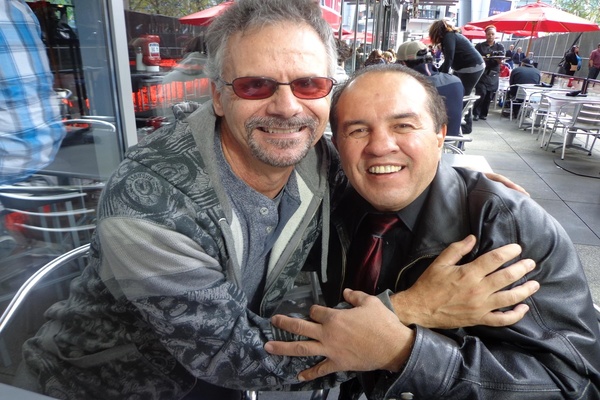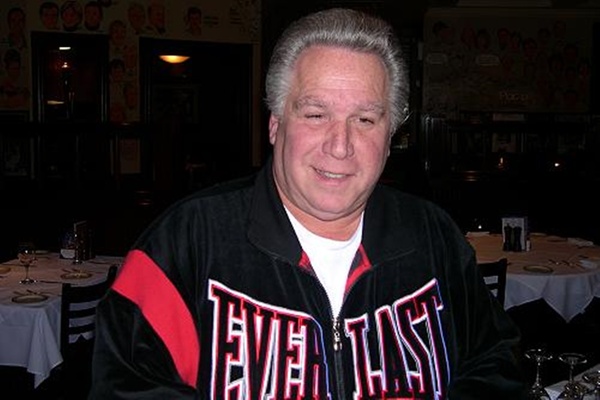Book talk-Beatboxing: How hip-hop changed the fight game by Todd Snyder
In this exclusive interview, Snyder talks about Muhammad Ali’s influence on hip-hop, the rap career of Roy Jones Jr., the socioeconomic similarities between hip-hop and boxing, and more.
Article by David Hopper

David Hopper, deputy editor of the music site 360°Sound, spoke with hip-hop scholar Todd Snyder about his new book Beatboxing: How Hip-Hop Changed the Fight Game (out now on Hamilcar Publications). The book chronicles how boxing and hip-hop became inextricably linked. Snyder, a native of West Virginia, interviewed numerous boxers, rappers, and prominent figures involved in both the sweet science and hip-hop.
Snyder is an Associate Professor of Rhetoric and Writing at Siena College. He is also the author of Bundini: Don’t Believe The Hype and 12 Rounds in Lo’s Gym: Boxing and Manhood in Appalachia. In this exclusive interview, Snyder talks about Muhammad Ali’s influence on hip-hop, the rap career of Roy Jones Jr., the socioeconomic similarities between hip-hop and boxing, and more. For the rest of the interview, head over to 360°Sound
This interview has been edited for length and clarity.
Hopper: Rapper Big Daddy Kane is quoted in your book saying that Muhammad Ali inspired him more than any other rapper. Ali was essentially a rapper before there was a name for hip-hop. Do you view Ali as the cornerstone for the intersection of boxing and hip-hop?
Snyder: Absolutely. If we were to create a pie chart and talk about all the socio-cultural factors that influenced the emergence of hip-hop, before there was such a thing, Ali is a huge chunk. From the very inception of hip-hop, a boxer is one of the key figures who influences the formation of the culture, the attitude, the bravado, the swagger. Lot of those early hip-hop pioneers wanted to be Muhammad Ali. [Big Daddy] Kane and Eric B. both were like, ‘I wanted to be Ali, that was my hero.’ [Kane’s] battling style was modeled after what Ali would do to his opponents.
I do believe Ali is a major, major cornerstone piece to pre-hip-hop and its history. I call them the pre-formation pioneers. You also gotta include Malcolm X and all these other figures who were influential to the attitude and the politics. And let’s not forget [Ali’s] sidekick, Drew “Bundini” Brown, who I wrote a book about in 2020. Bundini was the one who came up with ‘float like a butterfly, sting like a bee.’ And a lot of those rhymes are Bundini rhymes. He was sort of the mouthpiece, the poet laureate of Ali’s corner. It wouldn’t be like hip-hop like we know it today without Bundini and Ali.
Many boxers come from poverty as they try to punch their way out of their circumstances. A lot of rappers come from poverty as well and the genre originated in the inner city. Discuss the socioeconomic similarities between boxing and hip-hop and its role in why they’re so intertwined.
That’s one of the reasons I believe I fell in love with both. Because I always felt like boxing is for the underclass, the underdogs. Growing up where I grew up [in rural West Virginia], I certainly felt like that’s who I was. And hip-hop spoke to that sensibility as well, even though I was a white kid. I’d listen to Tupac and Biggie and all this stuff, and I felt like it was talking about people like me, even though it wasn’t directly per se. Both genres have always drawn from the lower rungs of society in regard to socioeconomic status. They’ve always drawn from the ghettos, the trailer parks, the hood. That’s one of the reasons the connection is so deep, why these boxers grew up around the rappers and vice versa. A lot of those folks were just trying to find a way out of their circumstances, positive ways out.
Sometimes if you don’t dig hip-hop and you don’t dig boxing, you look at those like, ‘How could punching someone be positive? How could hip-hop be positive? All the curse words and this and that.’ Both were positive outlets for kids who were trying to avoid gang life and the streets and alcohol and drugs and all the bad stuff that was out there. It was [rapper] Vinnie Paz who said to me, ‘Hip-hop is for everybody. You could be 4’8”, 120 pounds and be a dope rapper. You could also be the featherweight champion.’
Boxing is something everybody could do. Hip-hop is something anyone could do; you just had to be creative. The socioeconomic connection may be the primary connection. The difference between basketball and other sports and boxing is usually if kids have other sports they can play, that’s what they do. Boxing is from the least, so is hip-hop.
What do you consider to be some of the greatest hip-hop ring walks of all time?
One thing that we’ve had to push back against is there a lot of people who see the cover of the book and go, ‘This must be a book about hip-hop ring walks.’ It’s not the case at all. In fact, I tried to really scale back how much I wrote about that because there’s a lot of rap people who don’t like them. A lot of the rappers I interviewed were like, ‘They sound terrible.’ I would rather just play the music and walk in with your fighter, that’s what Tupac [Shakur] and [Mike] Tyson did. Tupac wasn’t rapping while he came into the ring.
Today, when you watch a fight, you see a mini rap concert. That’s such a big part of hip-hop showmanship. There are all these examples of rap concerts at the fights. Personally, I don’t think they’re that great either. I always listen to see who they’re going to come out to. And I love it when rappers are there, too. But nine times out of 10, they’re not very good. The only two I can think of that I thought were kind of interesting was when Zab Judah came to the ring with Shyne. That was one of the first ones to ever take place. That was when he fought Terron Millett [in 2000]. I thought that was a great performance by Shyne.
Deontay Wilder got a lot of hell for that ring walk against Tyson Fury in the second fight. But I thought D Smoke did a really great job with the poem he read, and “Black Habits” is a great song. I think D Smoke’s performance was really good. Unfortunately, Wilder’s costume became part of the conversation after the fight and his excuse that the costume was too heavy. That kind of ruined his performance because I thought it was a great performance. You could hear him, it wasn’t distorted, there wasn’t 20 guys yelling on the mic.
As far as boxers foraying into rapping, would you say Roy Jones Jr. was the most successful and prolific?
I don’t think any of them have mastered hip-hop obviously. But I do think Roy Jones garnered a level of respect and crossover success that is unparalleled. He was a not a great emcee, but he was creative, and he was charismatic, and he was connected with all those Dirty South pioneers, guys like [Rap-A-Lot label founder] James Prince, Scarface, and Lil Jon. He was a Southern boy who was hanging out with all these Southern rap legends.
“Y’all Must’ve Forgot” is a cool moment in boxing history, and hip-hop respected that. It was Inspectah Deck [of the Wu-Tang Clan] who put that line ‘I’m like Roy Jones “Y’all Must’ve Forgot”’ in one of his songs. The fact that he had rappers saying that phrase shows you that he had a level of crossover success. His albums didn’t go platinum or anything, but they were on the charts. So yeah, I give Jones credit. He’s still rapping to this day. I think Roy has to be the best ever, even though a lot of the rappers said to me he’s not a real emcee. But for an athlete, he’s pretty damn good.
Do you see hip-hop as critical to boxing’s future success and its ability to attract a younger demographic?
We’re going to see more shows like Triller that marry music and youth culture to boxing. Some will fizzle out, and some will have a little bit of staying power. But the connection between hip-hop and boxing is only getting bigger. The proof is that if you listen to new rappers like Westside Gunn or Benny the Butcher, these new guys, their music is full of references to Gervonta “Tank” Davis and Wilder. It’s full of references to new boxers. It’s not going anywhere.
Boxing has a lot to compete with. It’s got MMA, all the other professional sports, but rap is still paying attention to it. There’s probably no subculture in America that is more influential than hip-hop culture. It’s global now. I think the connection is going to become more visible, and I think we might be, in the immediate future, in a really fun era with a lot of young talented guys at lightweight and junior welterweight. The heavyweight division has been poppin’, too, the last couple years. Interesting fights. Some people complained about the Fury-Wilder trilogy, but I thought it was fun, certainly can’t-miss TV.
I think as far as one fighter to look for in the future who’s gonna help strengthen this is Shakur Stevenson. Hip-hop really pays attention to him. Lot of the rappers who I interviewed, I said, ‘Who do you like? Who do you watch?’ They all said Shakur Stevenson. Of course, Tank is another one, all the rappers watch Tank. If you’re looking for a gesture to the future, Stevenson and Davis are gonna be the guys.
Visit 360°Sound to read about Snyder’s favorite boxing-related rap song, the friendship between Mike Tyson and Tupac Shakur, and more!
Latest
SecondsOut Weekly Newsletter
Permission Statement
If you accept, we will process your data to fulfil this purpose.



